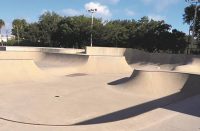 ArcusStone for the limestone look
ArcusStone for the limestone look
A California company has created a clever disguise — a concrete product that looks like quarried limestone block.
ArcusStone, based in Oakland, Calif., manufactures crushed limestone coatings and plasters that produce the finish of quarried stone, but with increased strength and durability due to the portland cement and polymers in the mix. ArcusStone’s technical director, Bill Tott, said the crushed limestone aggregate gives it its unique finish — it can be honed smooth or left pitted so it looks like cut limestone.
“The effect is to duplicate the look of a block of limestone or travertine, like quarried stone, but it’s only 3⁄8ths of an inch thick,” Tott said. “That’s what’s so great about it.”
ArcusStone is used in a huge range of residential or commercial applications, inside or out, from floors to ceilings. Inside, ArcusStone can be used to make wainscoting, arches, vaulted ceilings or even countertops. Outside, it’s used for gateposts, courtyard entrances, landscaping walls, facades, pool surrounds (such as the Kea Lani Hotel on the island of Maui) and walkways.
The company also offers ArcusStone Plaster, a limestone plaster, for interior and exterior use. The natural materials in the plaster create a mottled appearance that can be used to create a weathered look.
Owner Carol Kavalaris said the obvious advantage to ArcusStone over quarried stone is cost, not only in the material itself, but also in transporting heavy stone and finding craftsmen to cut and install it.
Both products can be sprayed or trowel-applied to nearly any stable substrate — existing stucco, concrete or drywall for example — and the contractors have a variety of design options, colors and textures at their disposal.
 Contractors who use ArcusStone products must be trained and certified by the company. Kavalaris said applicators have different styles — some specialize in the coloring and texturing processes that create a mottled, old-world look; some hire artists to do carvings; some hone the material to look like polished marble. She said the most common look is the replication of limestone block construction, but creative applicators often use the stone and plaster together to create a “rubble stone” effect (peeling plaster over an old stone wall).
Contractors who use ArcusStone products must be trained and certified by the company. Kavalaris said applicators have different styles — some specialize in the coloring and texturing processes that create a mottled, old-world look; some hire artists to do carvings; some hone the material to look like polished marble. She said the most common look is the replication of limestone block construction, but creative applicators often use the stone and plaster together to create a “rubble stone” effect (peeling plaster over an old stone wall).
In fact, the coating was developed in Europe in the early 1960s as a way to restore historic stone structures. ArcusStone adapted the technology to comply with American construction standards in 1988.
Kavalaris said she got into the business as an architectural designer who saw the endless possibilities with ArcusStone, a versatile and convincing substitute for cut stone. “The material itself really is stone, and that’s what you’re seeing even if it’s only 3⁄8" thick. It gives you complete control, and you can create things you can’t with other materials, such as ceilings and arches.”
For more information, visit the ArcusStone Web site or call (510) 535-9300.












